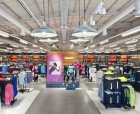Helvar controls lighting in Nike Factory store

Using Helvar 910 lighting routers to control DALI luminaires throughout the new Nike Factory store in Norwich has provided a complete lighting control system that enables quick switching between five different lighting scenarios. Each of the four routers carries two DALI lines, with each line being equipped to control up to 64 points. Connected to an Ethernet cable, the routers allow for ‘individual intelligence’, enabling a series of lighting scenes to be remotely selected via the touch panel, which is itself connected via an Ethernet cable.
The pre-programmed scenarios include base lighting, ‘shop open’, night safety, all luminaires at 100% and all luminaires off. An optional slider enables lighting output to be controlled, according to the track that each set of luminaires is connected to. Motion sensors in back-of-house areas will switch off lighting if no movement is detected.
Peter Hegarty of Child Graddon Lewis Architects & Designers, explains, ‘Having exceeded the requirements laid out under LEED standards, whereby at least 60% of a building’s lighting must be controllable via a mid setting, the project is expected to achieve LEED certification when it is tested.’








